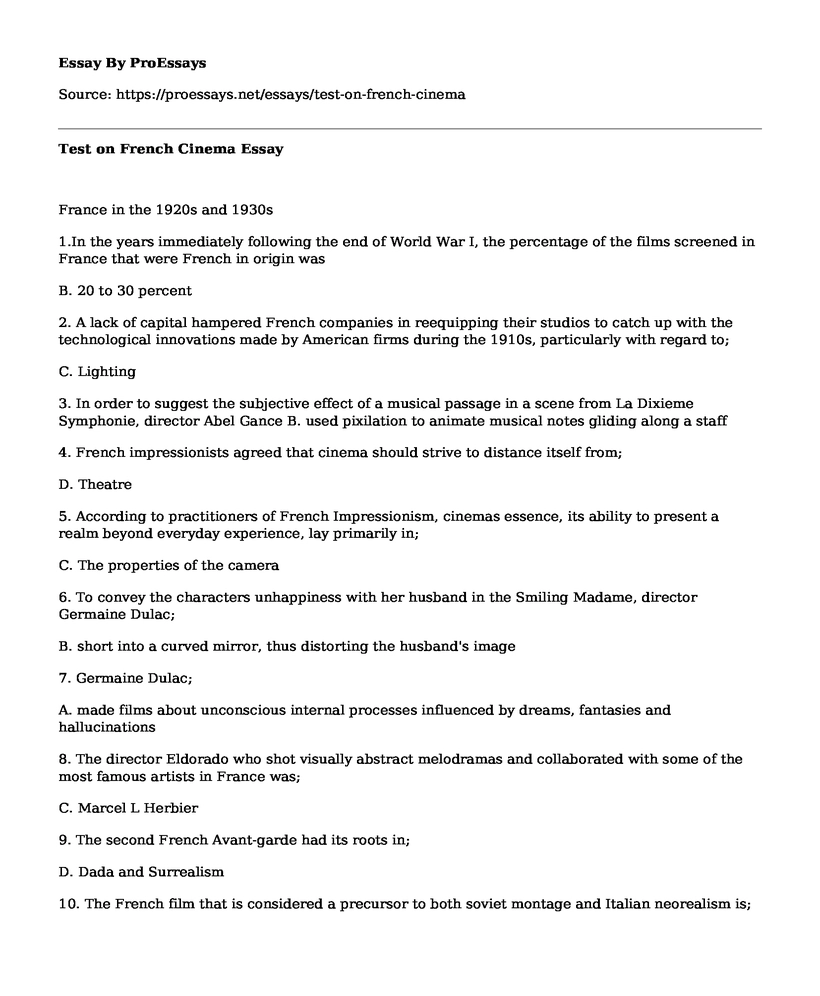France in the 1920s and 1930s
1.In the years immediately following the end of World War I, the percentage of the films screened in France that were French in origin was
B. 20 to 30 percent
2. A lack of capital hampered French companies in reequipping their studios to catch up with the technological innovations made by American firms during the 1910s, particularly with regard to;
C. Lighting
3. In order to suggest the subjective effect of a musical passage in a scene from La Dixieme Symphonie, director Abel Gance B. used pixilation to animate musical notes gliding along a staff
4. French impressionists agreed that cinema should strive to distance itself from;
D. Theatre
5. According to practitioners of French Impressionism, cinemas essence, its ability to present a realm beyond everyday experience, lay primarily in;
C. The properties of the camera
6. To convey the characters unhappiness with her husband in the Smiling Madame, director Germaine Dulac;
B. short into a curved mirror, thus distorting the husband's image
7. Germaine Dulac;
A. made films about unconscious internal processes influenced by dreams, fantasies and hallucinations
8. The director Eldorado who shot visually abstract melodramas and collaborated with some of the most famous artists in France was;
C. Marcel L Herbier
9. The second French Avant-garde had its roots in;
D. Dada and Surrealism
10. The French film that is considered a precursor to both soviet montage and Italian neorealism is;
A. Gances Napoleon
11. The French impressionist film that contains the first known use of single-frame shots in film history is;
D. La Roue12. Which of the mise-en-scene was not common to French Impressionism?
B. Employing highly exaggerated figure behaviour
13. Jean Epsteins La Glace a trios faces was unlike many French Impressionist films because of its;
A. innovative and ambiguous narrative design
14. The introduction of sound motion picture in the late 1920s made it virtually impossible for the impressionist to continue making impressionist films, primarily because;
B. Sound production was prohibitively expensive
15. The style of French poetic realism, which brought a new naturalism to the French cinema, was created by;
A. Director Jean Renoir.
16. The French transition to sound
C. strengthened the French industries position against the other European countries
17. The anarchic, surrealistic, lyrical film set in a boys school, featuring a slow-motion pillow fight scene and an assault on school dignitaries is;
D. Vigos Zero for Conduct
18. Stylistically the Grand Illusion is characterized by
D. Many visual effects influenced by French Impressionism
19. In the 1920s, French filmmakers went on location more often than did their counterparts in Germany or United States.
B. false
20. Stylistic techniques in French Impressionist cinema most often functioned to convey character subjectivity
A. True
21. Most of the narratives in French Impressionist films were as innovative and unconventional as the visual style
B false
Cite this page
Test on French Cinema. (2021, Mar 06). Retrieved from https://proessays.net/essays/test-on-french-cinema
If you are the original author of this essay and no longer wish to have it published on the ProEssays website, please click below to request its removal:
- Auditing a Website for Culture Diversity: Walmart
- Film Analysis Essay on Twelve Years a Slave
- Personality Disorder of Frankie in Frankie and Alice Movie Analysis
- Poetry Essay Example
- Essay Sample on Ellen Show: Impact on Society & Transforming Middle-Class Lives
- Essay Sample on 7 Key Aspects of Cultural Diversity: Respecting Differences, Empowerment & Max Potential
- Essay Example on The Seven Five: The Story of Michael Dowd's Crimes & Redemption







